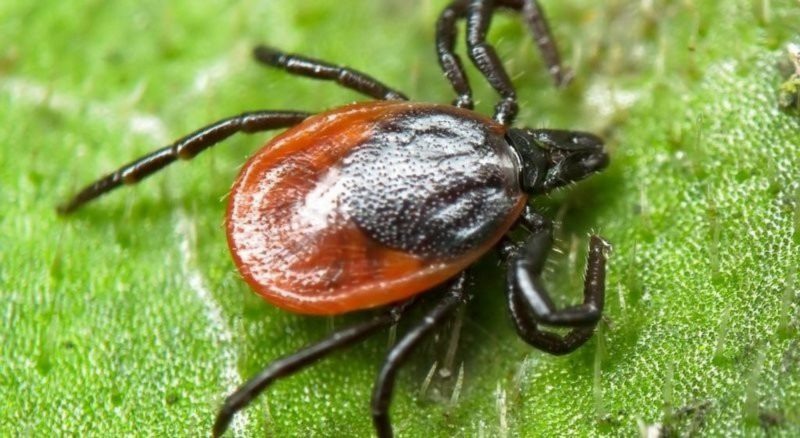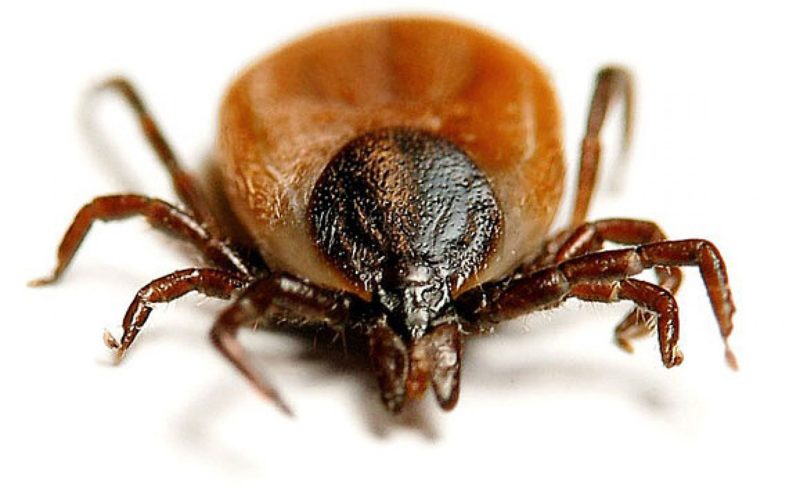One of the most dangerous arachnids for humans is considered a taiga tick. How can it harm people's health and how to protect themselves and loved ones from tick attacks?
Material Content:
What is a taiga tick?
Taiga tick is considered the most common representative of ixodid ticks. These arachnids often parasitize mice, dogs, and livestock, especially in spring and early summer. Moreover, on the host’s body they can be traced already swollen and nourished. In some areas, their numbers are so great that they can cover animals with a continuous layer.
- The body of the parasite consists of a head (proboscis) and a trunk. At the same time, the proboscis of hungry ticks is pointed and directed forward. This allows him to take a streamlined body shape and makes it easier to move around the victim’s body.
- Adults have four pairs of legs.
- Females are larger than males, their body length is 3 - 4 mm, males - 2 - 3 mm.
- The body shape is oval, protected by a black chitin shield (in hungry females, bodies are reddish-brown or dark red).
Soft covers cover the body of females, gathering in folds. During nutrition, the parasite spreads them, which allows the skin of the tick to increase during the absorption of blood. After such a feast, the body of the female increases by almost 7 times, and the mass is almost 200 times.
Ticks are temporary parasites, because, when saturated, they leave the body of the victim and continue to live in the external environment.
The entire period of parasitization is about 5% of the entire life cycle of insects, the rest of the time they live in soils.
Habitat and period of activity
A taiga parasite is a moisture-loving arthropod, and therefore lives mainly in forests, although it can also be found in meadows covered with dense grass. The climate softening over the past several decades has expanded the boundaries of the taiga tick habitat. So, in the first half of the XIX century, the tick lived mainly in the Siberian taiga. Now he is met in the Baltics, as well as in some areas of Mongolia and China, Kamchatka, Karelia of Kazakhstan, as well as in southern Japan and the Kuril Islands.
Development and growth of arachnid
Taiga ticks are able to mate directly during parasitization on an animal or among vegetation. After mating, the female lays about 2,000 eggs. After masonry, it dies, and after 3 weeks larvae form from the eggs, which are very small in size - 0.2 - 0.7 mm.
- Young ticks are called nymphs. They and larvae, in contrast to adults, have 6 legs. At the same time, the larvae cannot move at impressive distances, but growing up, they creep out, forming a spot, reaching tens of centimeters in diameter. At night and in the cold, the larvae hide under foliage, stones, and when heat sets in, crawl to the surface, waiting for the victim. After waiting for prey, the larvae attach to it and scatter over its body, sucking in the eye, groin and other places less covered with vegetation. Larvae feed on host blood for several days, gradually turning into an elongated “balloon”. After saturation, the “children” of the tick leave their prey and hide in shelter, preparing for molting.It is interesting. Taiga tick larvae parasitize not only mammals, but also birds and lizards.
- Gradually, new organisms - nymphs - materialize from the larva. They are very reminiscent of a female tick and have a dark brown torso covered with a shield. The hungry nymph reaches a length of 1.2 to 1.7 mm. For existence and development, she also needs the process of bloodsucking. Their victims are small animals, lizards, birds, and even humans.
- After some time, the nymph turns into an imago - a young female or male. Having strengthened, imagoes creep out, trying to find the owner, trying to climb higher into the bushes, grass, tree branches. At night they hide under the fallen leaves, and in the morning they go up again. The smell of ticks is very strong, they are able to notice the approach of prey from a distance of 15 - 20 m. Having sensed a potential victim, the tick takes a fighting stance, putting forward the front pair of legs. When the prey approaches, the tick adheres to it or descends to the ground and moves in its direction.
Interestingly, the life of the tick is largely due to seasonality. So, only hungry adults and well-fed larvae are able to winter. Eggs and well-fed females do not tolerate cold and are able to exist exclusively in the warm season.
What is dangerous for humans
What is the danger of a taiga tick?
The parasite attacks small animals from above, and chooses more flexible tactics in relation to humans. First, he gets to his feet and moves up, looking for delicate areas of the skin.
A bite of a taiga tick is dangerous for humans, although often it does not even feel it, since the parasite injects an anesthetic enzyme into the bloodstream. But these creatures are carriers of pathogens, especially females. They are able to make deep passages in the integument and remain in the tissues for a long time.
The carrier of what diseases is
Taiga tick - a distributor of tick-borne encephalitis, a disease that exists in several forms:
- Febrile. It is characterized by hyperthermia (38 - 39 ° C), lethargy and sleep disorders. The disease does not affect the nervous system.
- Meningeal. Manifested by inflammation of the meninges.In case of untimely seeking medical help, it can cause complications (hydrocephalus or seizures).
- Polyradiculoneuritis. It affects the brain and nervous system, which leads to a violation of the sensitivity of the limbs and other parts of the body.
- Meningoencephalitic. It can cause delusions, hallucinations, as well as loss of sensitivity of the muscles of the face. This form often provokes irreversible brain changes.
Tick is not the main cause of encephalitis. The danger lies in the viruses that he carries.
A taiga tick bite can also provoke borreliosis or Lyme disease.
What to do if bitten by a taiga tick
In Moscow, Leningrad and many other regions of Russia, tick activity occurs in May - June. If a person has found a parasite that has sucked on the body, one should not try to determine its appearance, much less pull it out on its own. In the process of healing, you can tear off the body, leaving a head under the skin, which will increase the risk of infection. You should immediately consult a doctor who will remove the arthropod, as well as conduct the necessary examination and determine whether a particular tick is the causative agent of the disease.
Tip. Infection can occur not only in the process of a bite, but even in the case of contact of a crushed tick with skin. Therefore, having discovered a parasite moving around the body, you should shake it and crush it with any objects (not with your bare hands) or simply burn it.
How to remove the parasite yourself
In the case when, after a tick bite, it is not possible to immediately visit the medical center, it is permissible to remove the parasite on its own.
This is done as follows:
- Form a loop of tight thread.
- With maximum care, throw it near the head of the tick.
- Inspect the wound. If there are fragments of the parasite, eliminate them with tweezers.
- The bite site is treated with an antiseptic.
- Contact the clinic.
The extracted tick should be placed in a resealable container and submitted for analysis.
Tip. If after a bite a person feels a malaise, even the slightest, you should immediately consult a doctor, since at first the symptoms can appear only in slight chills or slight pain.
Preventive actions
You can protect yourself from tick bites by tracking the danger in time while walking in nature.
To do this, observe a number of rules:
- Dress in dense clothes, trying to close all areas of the body. Pants tuck into shoes, a jacket tightly tied at the throat.
- Upon returning home, clothes are carefully inspected and shaken out on the street.
- It is also necessary to examine the whole body.
- In the forest, one should not advance in dense thickets of shrubs.
- If tick-borne encephalitis infections have been observed in the area, vaccination should be taken into account.
- The grass near the house should be regularly cut, not allowing the tick to populate
You can protect pets from tick attacks by using special collars and spray.
Going for a walk in the forest, it is useful to acquire special means to protect against contact with insects and ticks.
The most popular ones include:
- Repellents - lotions and sprays containing chemicals that repel parasites.
- Acaricides - not only scare away, but also kill ticks. It is permissible to apply such products exclusively on clothing (not on the skin). They can also be sprayed on plants in a specific area to destroy breams already seen.
In specialized stores you can find protective suits that guarantee safety from annoying insects, as well as ticks. It is not superfluous to take advantage of such protection when going for a walk in the forest.
A taiga tick is a small, but by no means harmless creature.Settling on the host’s body, it is able to become a carrier of dangerous diseases that affect the brain or nervous system. You can protect yourself from the consequences of meeting a parasite by observing safety measures during the period of the most tick activity.
















